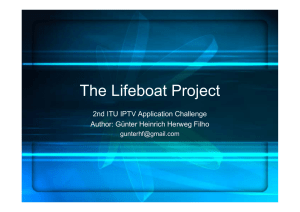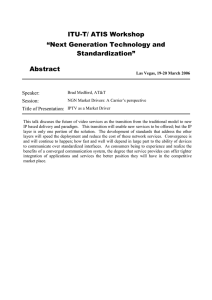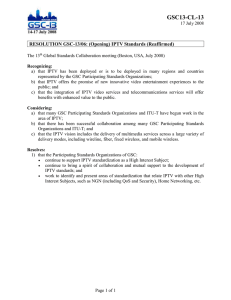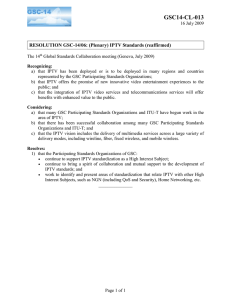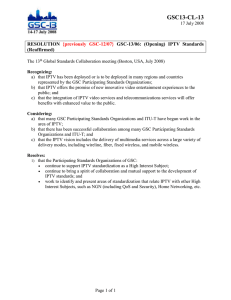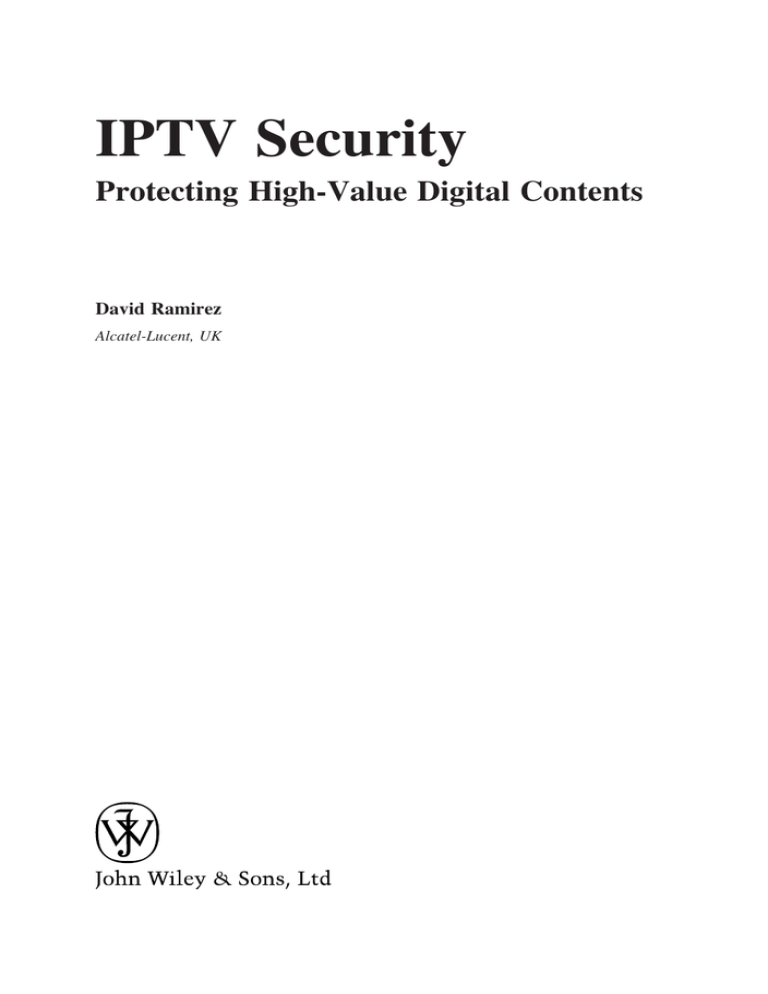
IPTV Security
Protecting High-Value Digital Contents
David Ramirez
Alcatel-Lucent, UK
This page intentionally left blank
IPTV Security
This page intentionally left blank
IPTV Security
Protecting High-Value Digital Contents
David Ramirez
Alcatel-Lucent, UK
Copyright © 2008
Alcatel-Lucent. All Rights Reserved.
Published by
John Wiley & Sons Ltd, The Atrium, Southern Gate, Chichester,
West Sussex PO19 8SQ, England
Telephone +44 1243 779777
Email (for orders and customer service enquiries): cs-books@wiley.co.uk
Visit our Home Page on www.wiley.com
All Rights Reserved. No part of this publication may be reproduced, stored in a retrieval system or transmitted in
any form or by any means, electronic, mechanical, photocopying, recording, scanning or otherwise, except under
the terms of the Copyright, Designs and Patents Act 1988 or under the terms of a licence issued by the Copyright
Licensing Agency Ltd, 90 Tottenham Court Road, London W1T 4LP, UK, without the permission in writing of the
Publisher. Requests to the Publisher should be addressed to the Permissions Department, John Wiley & Sons Ltd,
The Atrium, Southern Gate, Chichester, West Sussex PO19 8SQ, England, or emailed to permreq@wiley.co.uk, or
faxed to (+44) 1243 770620.
Designations used by companies to distinguish their products are often claimed as trademarks. All brand names
and product names used in this book are trade names, service marks, trademarks or registered trademarks of their
respective owners. The Publisher is not associated with any product or vendor mentioned in this book.
All trademarks referred to in the text of this publication are the property of their respective owners.
This publication is designed to provide accurate and authoritative information in regard to the subject matter
covered. It is sold on the understanding that the Publisher is not engaged in rendering professional services. If
professional advice or other expert assistance is required, the services of a competent professional should be
sought.
Other Wiley Editorial Offices
John Wiley & Sons Inc., 111 River Street, Hoboken, NJ 07030, USA
Jossey-Bass, 989 Market Street, San Francisco, CA 94103-1741, USA
Wiley-VCH Verlag GmbH, Boschstr. 12, D-69469 Weinheim, Germany
John Wiley & Sons Australia Ltd, 42 McDougall Street, Milton, Queensland 4064, Australia
John Wiley & Sons (Asia) Pte Ltd, 2 Clementi Loop, #02-01, Jin Xing Distripark, Singapore 129809
John Wiley & Sons Canada Ltd, 6045 Freemont Blvd, Mississauga, ONT, L5R 4J3, Canada
Wiley also publishes its books in a variety of electronic formats. Some content that appears in print may not be
available in electronic books.
Library of Congress Cataloging in Publication Data
Ramirez, David.
IPTV security : protecting high-value digital contents / David Ramirez.
p. cm.
Includes index.
ISBN 978-0-470-51924-0 (cloth)
1. Internet television. 2. Computer security. I. Title.
TK5105.887.R36 2008
621.388—dc22
2007039302
British Library Cataloguing in Publication Data
A catalogue record for this book is available from the British Library
ISBN 978-0-470-51924-0 (HB)
Typeset in 10/12pt Times by Integra Software Services Pvt. Ltd, Pondicherry, India
Printed and bound in Great Britain by Antony Rowe Ltd, Chippenham, England.
This book is printed on acid-free paper responsibly manufactured from sustainable forestry in which at least two
trees are planted for each one used for paper production.
I would like to take this opportunity to give special thanks to Luis Eduardo Niño
for taking a chance and trying my ideas, even if they were based more on hope and
ambition than on experience.
Also, I would like to give special thanks to Ramon Alonso Jaramillo for seeing
beyond the obvious and allowing me to learn, and to Carlos Mario Toro and John
Cuervo who guided my work and shared my enthusiasm for security.
This page intentionally left blank
Contents
Preface
About the Author
xv
xvii
1 Introduction to IPTV
1.1 Introduction
1.2 General Threats to IPTV Deployments
1.2.1 Access Fraud
1.2.2 Unauthorized Broadcasting
1.2.3 Access Interruption
1.2.4 Content Corruption
1
1
3
4
5
5
6
2 Principles Supporting IPTV
2.1 History of Video and Television
2.1.1 Television
2.2 Viewing Experience of Video
2.2.1 Line Scanning
2.2.2 Video Resolution
2.2.3 Number of Pictures per Second
2.2.4 Aspect Ratio
2.2.5 Video Compression Method
2.3 Video Compression
2.3.1 MPEG-2
2.3.2 H.263
2.3.3 MPEG-4
2.4 TCP/IP Principles
2.4.1 Addresses
2.4.2 Routing
2.4.2.1 IP Packet
2.5 Summary
References
Bibliography
9
9
10
15
15
15
16
16
16
16
17
18
18
19
19
20
20
21
22
22
viii
Contents
3 IPTV Architecture
3.1 High-level Architecture
3.1.1 Service Types
3.2 Functional Architecture for the IPTV Service
3.2.1 Content Provision
3.2.2 Content Delivery
3.2.3 IPTV Control
3.2.4 Subscriber Functions
3.2.5 Security
3.3 Detailed IPTV Architecture
3.3.1 Head End (IPTV Service Provider)
3.3.1.1 Critical Elements of the Head End
3.3.1.2 Content Input
3.3.1.3 MPEG Video Encoder
3.3.1.4 IP Encapsulator
3.3.1.5 Video Transcoder
3.3.1.6 Content Management Server
3.3.1.7 Video Repository
3.3.1.8 Digital Rights Management
3.3.1.9 Video Streaming Server
3.3.1.10 Subscriber Interaction
3.3.2 Transport and Aggregation Network (IPTV Network Provider)
3.3.2.1 RP and RTSP
3.3.2.2 RTSP
3.3.2.3 Ismacryp
3.3.2.4 PIM
3.3.2.5 MSDP
3.3.2.6 DSM-CC
3.3.2.7 Internet Service Provider
3.3.2.8 DSLAM
3.3.3 Home End (Subscriber)
3.3.3.1 Set Top Box
3.4 Summary
References
23
23
25
25
26
26
26
26
27
28
28
29
30
32
33
34
34
35
36
37
37
40
49
49
51
52
53
53
53
53
57
58
61
62
4 Intellectual Property
4.1 Introduction
4.2 Supporting Technology
4.2.1 Symmetric Key Cryptography
4.2.2 Asymmetric Key Cryptography
4.2.3 Hybrid Encryption
4.2.4 Hash – Digest
4.2.5 Commonly Used Algorithms
4.2.6 Public Key Infrastructure and ITU-T Recommendation X.509
4.2.7 Operation of PKI
4.2.8 Secure Socket Layer and Transport Layer Security
4.3 General Mechanisms for Content Protection
4.3.1 CPS
4.3.2 CAS
4.3.3 DRM
63
63
73
73
74
74
74
75
76
80
81
82
82
83
83
Contents
ix
4.4 Operation of DRM on IPTV
4.4.1 DRM Applied to VOD
4.4.2 DRM Applied to Broadcast TV
4.4.3 Smart Cards and DRM
4.4.4 Storage Protection
4.4.4.1 VCPS
4.4.4.2 CPRM/CPPM (CPSA)
4.4.5 Open DRMs
4.4.5.1 SDMI
4.4.5.2 OMA DRM
4.4.5.3 DMP
4.4.5.4 MPEG21
4.4.5.5 MPEG21 REL Data Model
4.4.5.6 DVB-CPCM
4.4.5.7 DVB-CBMS
4.4.5.8 PERM
4.4.5.9 DCAS
4.4.5.10 DReaM
4.4.5.11 OpenIPMP
4.4.5.12 OpenCA
4.4.5.13 PachyDRM
4.4.6 Interoperability Proposals
4.4.6.1 Coral
4.4.6.2 DMP
4.4.6.3 SmartRight
4.4.6.4 SVP
4.4.6.5 OpenCP
4.4.6.6 OMArlin
4.5 Watermarking and Fingerprinting
4.5.1 History
4.5.2 Steganography Techniques
4.5.3 Watermarking and Fingerprinting Principles
4.5.4 Typical Attacks
4.5.5 Forensic Use of Digital Fingerprints
4.6 WWW? (What Went Wrong?)
4.6.1 Introduction
4.6.2 Satellite Television
4.6.3 DVD Protection
4.6.4 AACS on Blue-Ray and HD-DVD
4.6.5 Videos Over the Web
4.7 Authentication
4.8 Summary
References
Bibliography
86
87
88
88
89
89
89
89
89
90
90
91
91
91
91
92
92
92
93
93
93
93
93
94
94
94
95
95
95
95
98
99
101
103
105
105
106
107
108
110
111
111
112
113
5
115
Existing Threats to IPTV Implementations
Co-authored by Andrew R. McGee, Frank A. Bastry and David Ramirez
5.1 Introduction to IPTV Threats
5.1.1 Specific Threats to IPTV Environments
5.2 IPTV Service Provider – Head End
5.2.1 Video Feeds – Live or Prerecorded (Physical Media, OTA, etc.)
118
120
125
126
Contents
x
5.2.2
5.2.3
5.2.4
5.2.5
5.2.6
5.2.7
5.2.8
5.2.9
5.2.10
5.2.11
5.2.12
5.2.13
5.2.14
5.2.15
5.2.16
5.2.17
5.2.18
5.2.19
Video Switch
Ingest Gateway (Video Capture)
Platform SW/OS – Stored/Running
Content Management System
Content Metadata from Video Repository
MPEG-2 Content from Video Repository
MPEG-4 Content
Load Balancer Software
Master Video Streaming Software
CA/DRM Service
SRTP Keys
Ismacryp Key
Key Management Protocol
CA/DRM Service Administration
VOD Application – Cached Video Content Metadata
Cached MPEG-2/MPEG-4 Content (Primary and Secondary Storage)
Video Streaming Software
Local Ad Insertion Authentication Information (e.g. User ID(s)
and Password(s))
5.2.20 Local Ad Metadata
5.2.21 Local Ad MPEG-2/MPEG-4 Content
5.2.22 Local Ad Insertion Tracking Information
5.2.23 nPVR Application Recorded/Stored Content Metadata
5.2.24 Recorded/Stored MPEG-2/MPEG-4 Content
5.2.25 nPVR/Video Recording Software
5.3 IPTV Network Provider – Transport and Aggregation Network
5.3.1 Protocol Vulnerabilities
5.3.2 Content Distribution Service: Unicast Content Propagation – FTP or Other
Transport Protocol
5.3.3 Multicast Content Propagation
5.3.3.1 IGMPv2/v3 (Snooping)
5.3.3.2 PIM (SM, SSM, Snooping)
5.3.3.3 MBGP
5.3.3.4 MSDP
5.3.3.5 MFTP
5.3.3.6 RTP
5.3.4 QoS Signaling (RSVP, DiffServ)
5.3.5 Management of Content Distribution Service
5.3.6 Connection Management Service
5.3.6.1 DSM-CC Protocol
5.3.6.2 RTSP Protocol
5.3.6.3 MPEG-2 Video Stream
5.3.6.4 MPEG-4 Video Stream
5.3.6.5 DSM-CC
5.3.6.6 RTSP
5.4 IPTV Subscriber – Home End
5.4.1 Set Top Box
5.4.2 STB Executing Software
5.4.2.1 DRM Software
5.4.2.2 Middleware Client SW
126
127
127
127
128
128
128
129
129
129
129
130
130
131
131
131
132
132
132
133
133
133
134
134
134
134
137
137
137
138
139
139
140
141
141
142
142
143
143
143
144
144
145
145
145
147
147
147
Contents
xi
5.4.2.3 STB Platform SW
5.4.2.4 DVR/PVR
5.4.2.5 STB Credentials
5.4.2.6 Digital Certificate (Software Provider)
5.4.2.7 STB Digital Certificate
5.4.2.8 Public Keys (Used for Digital Certificates)
5.4.3 STB User Storage
5.4.3.1 Downloaded Content
5.4.3.2 User-created Content
5.4.3.3 STB Smart Card
5.4.3.4 STB Credentials
5.4.3.5 STB Digital Certificate
5.4.3.6 STB High-definition Output Interface
5.4.3.7 DVI
5.4.4 Residential Gateway
5.4.5 DSLAM
5.4.5.1 Audience Metering Information
5.4.5.2 Fraud Control Information
5.4.5.3 IP Filters
5.4.6 Broadcast/Multicast TV VLAN Service
5.4.6.1 Decryption Keys
5.4.6.2 CWMP
5.4.6.3 NTP/SNTP
5.4.7 Broadcast/Multicast TV Application
5.4.7.1 MPEG-2 and MPEG-4 Video Stream
5.4.7.2 DSM-CC
5.4.8 Middleware Application
5.4.8.1 EPG
5.4.8.2 Menus
5.4.8.3 Subscriber Credentials
5.4.8.4 Purchasing Information
5.4.8.5 Digital Certificates (Content Provider)
5.4.8.6 Parental Controls
5.4.8.7 PVR/DVR Application
5.4.8.8 User-sourced Content
5.4.9 Application Management
5.4.9.1 IPTV Usage Information
5.4.9.2 IPTV Billing Information
5.5 Conclusion
148
148
149
150
150
151
151
151
152
152
152
153
153
154
154
154
154
155
155
156
156
157
157
158
158
158
158
158
159
159
160
161
161
162
162
163
163
164
165
6 Countering the Threats
6.1 Securing the Basis
6.1.1 Hardening Operating Systems
6.1.2 Business Continuity
6.1.3 Intrusion Detection/Intrusion Prevention
6.1.4 Network Firewalls
6.1.5 Fraud Prevention
6.1.6 DRM–CAS
6.2 Head End (IPTV Service Provider)
6.2.1 Critical Elements of the Head End
6.2.2 Content Input
167
167
167
172
173
174
175
176
176
176
177
xii
Contents
6.2.2.1 Satellite Feed
6.2.2.2 Premium and Direct-feed Content, Pre-encoded Content Ready to be
Encapsulated
6.2.2.3 Physical Media
6.2.3 MPEG Video Encoder and Video Transcoder Functions
6.2.4 IP Encapsulator
6.2.5 Content Management Server
6.2.6 Video Repository
6.2.7 Digital Rights Management
6.2.8 Video Streaming Server
6.2.8.1 IGMPv2/v3
6.2.8.2 MBGP
6.2.8.3 MSDP
6.2.8.4 RTP
6.2.8.5 RTSP Packets
6.2.8.6 RSVP
6.2.9 Middleware Server
6.3 Aggregation and Transport Network
6.3.1 DSLAM
6.3.1.1 Access and Session Control
6.3.1.2 Routing
6.3.1.3 User Segregation
6.3.1.4 Quality of Service
6.3.1.5 Virtual Networks and Virtual Circuits
6.3.1.6 802.1X Authentication
6.3.2 Firewalls
6.4 Home End
6.4.1 Residential Gateway
6.4.1.1 Filtering
6.4.1.2 Quality of Service
6.4.2 Set Top Box
6.4.2.1 Secure Processor
6.4.2.2 DRM
6.4.2.3 Output Protection
6.5 Secure IPTV a Reality
References
177
178
179
179
180
182
182
184
187
188
188
188
188
189
189
189
190
190
191
193
193
194
194
195
196
197
197
197
198
198
198
200
200
201
202
Appendix 1 Converged Video Security
A1.1 Introduction
A1.2 Threats to IPTV Deployments
A1.3 Protecting Intellectual Property
A1.4 VOD and Broadcast
A1.5 Smart Cards and DRM
A1.6 Countering the Threats
A1.6.1 Threat References
A1.6.2 Threat Models
205
205
205
206
207
208
208
210
211
Appendix 2 Federated Identity in IPTV Environments
A2.1 Introduction
A2.2 IPTV Federated Identity Solutions
A2.2.1 SAML for Security
217
217
217
218
Contents
xiii
A2.2.1.1 The SAML Process
A2.2.1.2 Reviewing Existing Standards
A2.3 Applicability to an IPTV Security Environment
A2.3.1 Internal Applications
A2.3.2 Set Top Box Security
A2.4 Video on Demand
218
220
220
220
221
221
Appendix 3 Barbarians at the Gate
A3.1 Barbarians at the Gate
A3.2 How to Break an IPTV Environment
A3.3 Network Under Siege
A3.3.1 Confidentiality
A3.3.2 Integrity
A3.3.3 Availability
A3.4 Countermeasures
A3.4.1 Set Top Box
A3.4.2 DSLAM
A3.4.3 Routing
A3.4.4 User Segregation
A3.4.5 Quality of Service
A3.4.6 Virtual Networks and Virtual Circuits
A3.5 Conclusion
223
223
224
224
224
225
225
225
225
226
227
228
228
229
229
Index
231
This page intentionally left blank
Preface
Paraphrasing the famous quote from Karl Marx, I would say that television is the opium of
the masses. If we have any doubts, we just need to look at the number of people glued to
the TV every day. I fully understand this inclination. When I was young I spent most of my
time looking at the world through the TV. Many images and sounds that now as an adult
I try to revisit in person. For many of us, black-and-white TV is still a memory (not just
a scary story or an urban myth!). We lived with just a few TV channels that started in the
morning and by late afternoon were finished. Only in recent years have we had access to
cable packages with hundreds of channels and basically any topic we may want to see.
For many years, TV has been a central mechanism for sharing culture. Although books,
music and radio are helpful in bringing an insight into other worlds, audiovisual messages
are more powerful and gain more attention from the audience. TV is also cheaper than live
performances, and the audience is constantly growing as the number of TV sets per family
increases. In many countries, TV channels are closely controlled by the political power,
which ensures that only acceptable contents are presented to the public. New technologies
may change this environment, allowing subscribers to choose what they see and select from
different sources worldwide.
Being a TV fan, it was very interesting to get involved in the topic of IPTV. It was almost
by accident that I was requested to write a chapter for an IPTV book in 2005. I had to jump
head first into the subject and learn as much as I could about IPTV. One of the conclusions
from my initial research on the topic was that information was limited, mostly linked with
specific products, and some information lacked structure. This is a common situation with
new technologies – there are very clever people developing the technology and they have
little time to share all the details with the world.
I expanded the topic of IPTV in my MSc dissertation and, as a result of this additional
research, concluded that writing a book on the specific aspects of security could be a positive
contribution for those interested in the subject. The writing process became a very interesting
journey as I was faced with the challenge of structuring in a coherent way a number of
separate areas that span different knowledge domains. I tried to replicate my learning process
in the book, bringing together all the diverse subjects that form IPTV in a single document
that would allow the reader quickly to gain insight into the components and interactions
within IPTV environments.
xvi
Preface
In general, most of the information available on the subject was either related to particular
products or was work in progress expected to become a standard in the future. The book
intends to provide detailed information about the different elements that comprise the IPTV
environment, filling in some of the gaps left by available information.
The most exciting part of exploring IPTV is realizing how subscribers will have the
power to control most aspects of their viewing experience. It may not start with the death
of television as we know it, but in years to come subscribers will be able to choose
exactly when and what type of content they want to access. Today we have a few IPTV
deployments worldwide, and these are slowly gathering momentum. This technology will
definitely become an alternative to satellite and cable.
Moreover, as we have seen with many other technologies, the first versions do have
security vulnerabilities. More specifically, IPTV is a highly complex environment that brings
together technologies from many different vendors, and this increases the potential for
security problems. The journey of exploring the security of the IPTV environment clearly
shows that there are hundreds of potential points of failure. Many components can become
the weakest link and allow intruders to have access to digital assets or components within
the IPTV environment.
Hopefully, this book will help security professionals gain a broader picture of the
challenges and tools available to secure the environment and ensure that security incidents
are reduced and controlled.
About the Author
David Ramirez
Senior Manager
Alcatel-Lucent Services
David Ramirez has been involved with information security for the past 13 years. He
began his career as a networking specialist and then joined a consulting company managing
information risk management practice where he was involved in risk assessments for more
than 80 companies. His next move was to a risk management company in the UK, as part of
their new information security division. In that role, Ramirez was responsible for developing
the methodologies for the practice, including penetration testing, ISO 17799 compliance
and disaster recovery. He was involved in security projects for banks and other financial
institutions around the world. The projects focused on security awareness, disaster recovery
and business continuity, security policies, security architecture, managed security services
and compliance with international standards.
Ramirez is a member of Alcatel-Lucent’s security consulting practice. His responsibilities
include innovation and technology, thought leadership and knowledge sharing.
This page intentionally left blank
1
Introduction to IPTV
1.1 Introduction
Television is one of the inventions that has shaped the way society and culture has evolved in
the past 60 years. Back in 1940, the first commercial television broadcast started a revolution,
showing people of all ages how others lived outside their towns and cities. Television had a
powerful effect, shrinking the world and creating a unified view of how things were.
In 1969, ARPANET was created, and a new stage in communications started. Then, in
1983, the core protocol of ARPANET went from NCP (Network Control Protocol) to TCP/IP
(Transfer Control Protocol/Internet Protocol) and the Internet was born.
Both the TV and the Internet have revolutionized the way we live. We now have
TV channels providing information 24 hours a day, and the Internet facilitating both
communication and commerce. Several common areas between the two have finally drawn
the technologies into merging, creating IPTV (Internet Protocol Television).
There are some differences between IPTV and IP video. Although the two terms are very
similar, there is a clear distinction in the way the market is using the two. IPTV can be used
to refer to commercial offerings by service providers with very close access to the subscriber
and offers a number of TV channels with a similar look and feel to standard television. IP
video is more common within websites and portals, offering downloadable contents and,
in some cases, even TV shows and movies downloaded on demand. If it has a number of
channels and acceptable quality, it would be called IPTV.
IPTV is a new technology that enables much more flexibility to manage contents and
facilitates direct interaction with the sources of content, improving the feedback and future
planning. The customer experience is greatly improved by allowing more control over the
type of contents immediately available, as well as two-way communication with content
providers.
A few years ago, another new technology shocked the entertainment industry – the
infamous Napster enabled people to share music and movies in an unprecedented way. With
IPTV Security: Protecting High-Value Digital Contents David Ramirez
© 2008 Alcatel-Lucent. All Rights Reserved
2
IPTV Security
this technology it was not just the case of a neighbor lending a VHS tape with an old movie.
With Napster, people shared prerelease albums and videos, creating significant losses for the
music industry and movie studios.
Napster was eventually shut down in 2001, but several peer-to-peer (P2P) networks
appeared and the phenomenon grew dramatically, reaching millions of users worldwide.
Checking e-mule would confirm an average user base of 600–900 million users worldwide.
At the same time, several providers have started to offer legal downloads to the general
public. Anyone can buy music and video files. The entertainment industry has added digital
rights management (DRM) capabilities to the files and applications used to reproduce the
contents, which enables a sustainable model for sales of digital content. Recently, some
online stores have even removed DRM to calm the complaints from their subscribers related
to fair use of the contents. Users feel that, once they have paid for content, they should be
able to enjoy it on any device, and DRM is blocking that fair use possibility.
The recently born IPTV industry will need to address the same issues that once affected
the digital media distributors. Customers tend to share information, and over the years there
have been a number of very clever pieces of software that enable people to share information
and content. A recent example of the phenomenon is Freenet, a reportedly headless network
of nodes, storing encrypted sections of content and sending it to anyone who requests a
particular piece of data. With Freenet it is very difficult to find who is sharing illegal material,
and hence the enforcement of intellectual property rights and copyright restrictions becomes
more difficult.
One of the main risks faced by the industry is the rise of thousands of ‘home-made
stations’ willing to broadcast DRM-protected contents. One example of the technology that
will come in the future is VideoLAN. This software enables multimedia streaming of MPEG2, MPEG-4, DVDs, satellite and terrestrial TV on a high-bandwidth network broadcast or
unicast. If Freenet and VideoLAN meet, then there will be thousands of encrypted stations
broadcasting content outside any control of regulators.
However, the IPTV industry not only has DRM and content protection issues, customers
are used to an always-on service with consistent quality. IPTV would have to maintain high
levels of availability to convince subscribers that this is a viable option.
With a worldwide trend in privacy protection laws, all the information sent and received
from the customer must be protected from third parties trying to capture information. The
wireless LAN/WAN markets are a prime example that bad publicity happens to good people.
IT managers are not purchasing the technology because of fear, uncertainty and doubt around
the potential risks of deploying wireless networks.
Many problems that have affected the cable and satellite industry in the past will gradually
migrate to the IPTV service providers, with the increased impact of IPTV providing a twoway communication that includes logical paths connecting TVs to the Internet, and with that
environment come computer worms and viruses. IPTV service providers must ensure that
subscribers are not able to attack the servers providing contents, and also protect subscribers
from the Internet and other subscribers. Most importantly, the shared infrastructure with
other services has to be protected.
All those risks and threats must be addressed to achieve a profitable business model. The
following chapters of this book will cover some of the basic measures required to implement
IPTV security.
Chapter 1 will cover an initial reference to threats to IPTV infrastructures, including
known attacks and effects on the IPTV solution.
Introduction to IPTV
3
Chapter 2 will cover references to the IPTV architecture, operation, elements and known
requirements. This will provide the novice with background to understand the technology.
Chapter 3, under the title of Intellectual Property, will cover the requirements that content
owners have placed on service providers to protect contents from unauthorized access.
Chapter 4 provides a technical overview of the threats faced by IPTV and how these can
affect the infrastructure and applications.
Chapter 5 is based on the International Telecommunications Union (ITU) X.805, a standard
that covers end-to-end security for communication networks.
Chapter 6 will provide a summary of the technology, threats and countermeasures.
The material found in this book will allow readers to understand the basic concepts
supporting IPTV and existing threats to the IPTV environment, and will provide a structured
approach to defining what countermeasures are relevant and required for the appropriate
protection of the IPTV environment.
1.2 General Threats to IPTV Deployments
IPTV market growth and adoption is benefiting from the increased bandwidth available as
part of new broadband services on a number of different technologies. DSL, cable, mobile
phones and Wimax are just a few examples of the type of technologies now offering enough
bandwidth for acceptable service levels and customer experience.
It is important to remember that the IPTV business model is based on the general public
being able to access intellectual property owned by third parties and being distributed by
service providers. Both content owners and service providers derive their revenues from the
secure operation of the service. If content were disclosed in digital form and full quality,
then the potential revenue would be greatly reduced. The symbiotic relationship between
content owners and service providers depends on the use of technological mechanisms to
reduce the risk of unauthorized release of the digital media. Most cases include the use of
DRM and other security solutions to ensure control over the distribution and access.
What are the threats, risks and vulnerabilities that the industry is trying to overcome?
There are two main areas of concern:
1. The underlying communication technology used to send the content to the subscribers.
This is composed of the networking equipment and communication equipment linking
the display to the source of data.
2. The second area is the IPTV-related equipment. This is a series of elements designed
to operate the IPTV service and provide access and information to enable the service to
operate.
Compared with traditional voice/data networks or cable TV infrastructure, threats to an
IPTV environment are far more severe. The whole environment can be affected by a single
computer worm. IPTV environments are formed by homogeneous hardware and software
platforms. In most cases, one or two operating systems would be used for all the set top
boxes deployed, but, if a computer worm were to affect the network, then a minimum of
50% of all set top boxes (and subscribers) would be out of service for a period of time.
Carriers also need to ensure that quality of service is protected to comply with customer’s
expectations and service level agreements (SLA).
4
IPTV Security
Those two main areas of concern can be translated into specific threats and risks to the
IPTV service.
1.2.1 Access Fraud
Access fraud is one of the oldest forms of fraud within premium/paid TV. This situation
happens when an individual circumvents the conventional access mechanisms to gain
unauthorized access to TV contents without paying a subscription or increasing the access
granted.
An example of the type of threats faced by IPTV vendors comes from the satellite TV
industry. For years they have been fighting access fraud. The widespread nature of fraud has
caused, during recent years, some satellite TV companies to start taking legal action against
defendants for unauthorized access to TV content. A whole industry was developed around
the provisioning of modified access cards allowing unlimited access to TV packages and
eroding the revenue of satellite TV vendors.
The experience of the satellite TV industry shows that fraudsters go to great lengths to
break the existing security measures. This includes cracking the smart card protection used
for the set top boxes and distributing cloned ‘free access’ cards. Even though the satellite
TV providers modified the cards, fraudsters have managed to find alternative ways to break
the safeguards incorporated in the new releases, and this cycle is repeated constantly.
Now that video technology has entered the IP world, the level of threats has escalated –
vulnerabilities that have been solved in other, more mature technologies are still part of
the new IPTV systems. There is a recent example of a major TV provider stopping their
online content distribution owing to security vulnerabilities being found and exploited on
the digital rights management technology protecting the content. There could be numerous
vulnerabilities discovered on IPTV systems while the infrastructure reaches a higher maturity
level. It is important to ensure that the underlying platform has the state of the art in relation
to security mechanisms and procedures. This will add protection layers to the environment
and will limit the effect of vulnerabilities discovered.
Another relevant example is the constant battle between cable operators and users. In many
cases, cable modems have been modified to uncap the access to the network. This situation
is presented when someone has access to the configuration function of the cable modem via
the software interface or, in some cases, even access to hardware components within the
cable modem and the bandwidth and other restrictions are removed. There are sites on the
Internet where modified cable modems are offered, as well as kits and instructions to modify
the configuration and remove the bandwidth limitations.
IPTV is transferred not only to set top boxes but also to computers and handheld devices.
This facilitates the process of breaking the security of contents. Intruders could manipulate
or modify the behavior of their IPTV client and extract the content in digital form ready to
be copied or broadcast. Simple software modifications introduced by hackers allow them to
break the encryption system and other security measures, or even capture and redistribute
the contents using peer-to-peer networks.
The main fact related to access fraud is that, in order for an IPTV system to work,
end-users have to be provided with the encrypted content, encryption algorithm and the
encryption keys. Anyone familiar with these technologies will tell you that you have lost
the game at that point as you no longer have control over the content. Historically, these
Introduction to IPTV
5
types of environment show that eventually someone will be able to break the protections
and release the content.
Access fraud is reduced greatly by the implementation of different technologies intended
to block any attempt at unauthorized access, for example:
• The STB has a DRM client needing to liaise with the DRM application to receive the
valid keys for the content. Any third party with access to the content will not be able to
decrypt the information as no valid keys have been issued for them.
• Communication with the middleware servers is protected using SSL, and STBs can be
authenticated, ensuring that only valid systems are accessing the content.
• DSLAMs are able to validate that only valid subscribers are able to connect to the network
and communicate with the middleware servers. The physical line used for access to the
network is mapped with the MAC and IP address used by the subscriber and is validated to
ensure authorized access. The DSLAM will block any access between systems, avoiding
peer-to-peer connections that may result in hacking incidents or unauthorized access to
content.
1.2.2 Unauthorized Broadcasting
IPTV contents are distributed in digital format, simplifying the work of any individual with
an interest in copying or broadcasting the contents. One of the arguments in the campaign
against movie piracy is that bootleg DVDs tend to be recordings made at the cinema by
people using handheld cameras. However, with digital content broadcast as part of an IPTV
service there is no difference between pirate and original content.
A major impact on the satellite TV industry has been fraudsters selling modified ‘all
access’ smart cards based on modifications to valid smart cards and receivers. If fraudsters
are successful at the same type of attack within an IPTV environment, they will be able
to create ‘all access’ IPTV set top boxes or cards. As a result, the IPTV industry faces an
entirely new threat – with broadcasting stations residing on every home PC, hackers would
be able to redistribute the broadcast stream to other computers all over the world. There are
some known cases where individuals have offered redistribution of sport events, charging
interested people a small fraction of the commercial cost of accessing the content.
Taking as an example the widespread effect of peer-to-peer networks and how easy it
is to use one of these environments to distribute large amounts of data, it is technically
feasible to set up a peer-to-peer network used to distribute broadcast IPTV content. One
single source could be used to deliver contents to nonpaying viewers around the world. This
is a clear danger to the business model followed by content owners and service providers.
A valid subscriber could take digital content and use peer-to-peer networks to distribute the
high-quality content to a large audience, eliminating the need for those viewers to pay for the
content or maintain any subscription to commercial TV services. All the technology pieces
are available for this situation to arise.
1.2.3 Access Interruption
Television is a service that people take for granted – the public expects to click the button
and get something on the screen. If an intruder were able to damage the infrastructure or
6
IPTV Security
one of the service components, then customers would loose access to their services, causing
a loss of confidence in the service. Cable operators offer a pretty much reliable service, and
customers would compare the reliability of IPTV networks against other solutions.
Security and reliability must be built into the architecture to ensure that the service is
always available and any interruptions are quickly solved.
The way most IPTV solutions are deployed creates a number of risks, especially from fastreplicating attacks such as the ones from worms and viruses. A worm capable of attacking
the set top boxes could bring down several hundred thousand boxes in seconds and, properly
coded, would cause an outage of weeks while technical support people recovered the boxes to
their original state. Similar attacks could be launched against web-based middleware servers,
leaving all viewers without access to their electronic programming guide.
STBs tend to have the same operating system within a particular service provider. If the
central server were infected by a worm or virus, it would be a matter of seconds before all
STBs were infected, easily bringing the service down.
The major weaknesses within the IPTV environment, related to access interruption, are as
follows:
• Middleware servers, even if deployed in a high-availability environment, are a single point
of failure. If vulnerability were exploited on the servers, then intruders could shut down
the middleware servers.
• Denial of service is also a major risk within the middleware servers. If there are
no appropriate mechanisms, intruders could send a number of invalid requests to the
middleware server, blocking access by valid users.
• DSLAMs tend to have the same operating system. If an intruder is capable of affecting
the configuration of a number of DSLAMs, then thousands of users would be left without
service. An additional problem is that some DSLAMs tend to be deployed in rural areas
with limited access by support personnel, and recovering service may take from several
hours to several days.
• STBs tend to run known operating systems, and a worm exploiting vulnerability on those
systems could shut down all STBs simultaneously, even disabling the STB permanently
until a technician has physical access to the system.
• Residential gateways present the same type of risk. A massive attack could shut down all
RGs and leave customers without access.
• There are similar risks within the IPTV core components. For example, if an intruder
were to disable the broadcast server or video-on-demand server at the regional head end,
thousands of subscribers would loose access to the server. This is valid for the DRM and
other IPTV components at the head end. In general, the whole infrastructure should be
designed following an approach of high availability.
1.2.4 Content Corruption
The resources and funding required to broadcast over-the-air fake signals are so large that
this is something usually left for military use. There are no frequent cases of people starting
their own TV station and blasting their message to large regions of a city or even across
cities. Cable operators have to their advantage that any modification to the signal requires
physical access and can be easily tracked.

